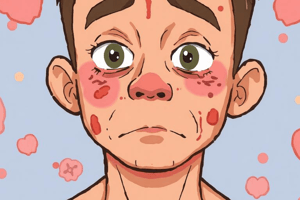Podcast
Questions and Answers
Which characteristic is NOT associated with the lining mucosa?
Which characteristic is NOT associated with the lining mucosa?
- Ability to be stretched and compressed
- Moist surface
- Softer surface texture
- Presence of keratinized epithelium (correct)
What type of mucosa is characterized by its ability to withstand mechanical forces?
What type of mucosa is characterized by its ability to withstand mechanical forces?
- Specialized mucosa
- Submucosa
- Masticatory mucosa (correct)
- Lining mucosa
Which of the following structures would typically be covered by lining mucosa?
Which of the following structures would typically be covered by lining mucosa?
- Tongue surface
- Gums
- Hard palate
- Cheeks (correct)
Fordyce spots are described as which of the following?
Fordyce spots are described as which of the following?
Which type of epithelium is most associated with the lining mucosa?
Which type of epithelium is most associated with the lining mucosa?
What is the clinical appearance of lining mucosa in a healthy state?
What is the clinical appearance of lining mucosa in a healthy state?
Which area of the mouth would typically NOT respond to a change in mucosal appearance?
Which area of the mouth would typically NOT respond to a change in mucosal appearance?
What main feature distinguishes specialized mucosa from lining and masticatory mucosa?
What main feature distinguishes specialized mucosa from lining and masticatory mucosa?
What is the origin of melanocytes in the oral mucosa?
What is the origin of melanocytes in the oral mucosa?
What condition may lead to localized pigmented areas as the oral tissue ages?
What condition may lead to localized pigmented areas as the oral tissue ages?
Which medication is known to induce pigmentation changes in the oral mucosa?
Which medication is known to induce pigmentation changes in the oral mucosa?
What is a potential cause of an amalgam tattoo in the oral cavity?
What is a potential cause of an amalgam tattoo in the oral cavity?
Which condition is associated with the progression of HIV to AIDS in terms of oral manifestations?
Which condition is associated with the progression of HIV to AIDS in terms of oral manifestations?
What is the primary type of epithelium found in the nonkeratinized stratified squamous mucosa?
What is the primary type of epithelium found in the nonkeratinized stratified squamous mucosa?
What anatomical feature aids in speech and swallowing due to its elastic tissue?
What anatomical feature aids in speech and swallowing due to its elastic tissue?
Which characteristic is typically observed in the clinically healthy appearance of the masticatory mucosa?
Which characteristic is typically observed in the clinically healthy appearance of the masticatory mucosa?
What is an important consideration for surgical incisions in areas covered by masticatory mucosa?
What is an important consideration for surgical incisions in areas covered by masticatory mucosa?
What can happen rapidly in areas of masticatory mucosa if infection occurs?
What can happen rapidly in areas of masticatory mucosa if infection occurs?
What contributes to the firmer base of the mucosa in the areas with rete ridges?
What contributes to the firmer base of the mucosa in the areas with rete ridges?
Which of the following describes the unique resilience of the masticatory mucosa?
Which of the following describes the unique resilience of the masticatory mucosa?
What is the primary reason local anesthetic injections are easier in areas of masticatory mucosa?
What is the primary reason local anesthetic injections are easier in areas of masticatory mucosa?
Identifying areas of masticatory mucosa involves recognizing what characteristic?
Identifying areas of masticatory mucosa involves recognizing what characteristic?
What feature of the masticatory mucosa contributes to its protective role?
What feature of the masticatory mucosa contributes to its protective role?
What type of epithelium is primarily associated with masticatory mucosa?
What type of epithelium is primarily associated with masticatory mucosa?
Which statement accurately describes the discomfort associated with local anesthetic injections in masticatory mucosa?
Which statement accurately describes the discomfort associated with local anesthetic injections in masticatory mucosa?
What unique feature defines the specialized mucosa in the tongue?
What unique feature defines the specialized mucosa in the tongue?
How does the turnover time of nonkeratinized buccal mucosa compare to that of keratinized gingiva?
How does the turnover time of nonkeratinized buccal mucosa compare to that of keratinized gingiva?
Why might swellings in the masticatory mucosa cause greater discomfort when associated with infections?
Why might swellings in the masticatory mucosa cause greater discomfort when associated with infections?
In which part of the oral cavity is the attached gingiva typically found?
In which part of the oral cavity is the attached gingiva typically found?
What is the typical turnover time for junctional epithelium?
What is the typical turnover time for junctional epithelium?
Which characteristic does NOT describe masticatory mucosa?
Which characteristic does NOT describe masticatory mucosa?
Why are sutures rarely needed in areas with masticatory mucosa following surgical procedures?
Why are sutures rarely needed in areas with masticatory mucosa following surgical procedures?
What feature distinguishes keratinized epithelium from nonkeratinized epithelium in the context of oral mucosa?
What feature distinguishes keratinized epithelium from nonkeratinized epithelium in the context of oral mucosa?
What kind of epithelial transformation occurs in response to frictional or chemical trauma?
What kind of epithelial transformation occurs in response to frictional or chemical trauma?
Which histological feature is present in hyperkeratinized tissue?
Which histological feature is present in hyperkeratinized tissue?
In which type of mucosa is hyperkeratinization predominantly observed?
In which type of mucosa is hyperkeratinization predominantly observed?
What potential cause is suggested for hyperkeratinization of the buccal mucosa?
What potential cause is suggested for hyperkeratinization of the buccal mucosa?
Which area of the oral cavity is described as having irregular hyperkeratinized areas due to possible trauma?
Which area of the oral cavity is described as having irregular hyperkeratinized areas due to possible trauma?
How is the hyperkeratinized area along the buccal mucosa characterized?
How is the hyperkeratinized area along the buccal mucosa characterized?
What is a possible causative factor for the hyperkeratinization pattern seen in the area where teeth meet?
What is a possible causative factor for the hyperkeratinization pattern seen in the area where teeth meet?
What is the characteristic appearance of the hyperkeratinized area on a trauma-affected hard palate?
What is the characteristic appearance of the hyperkeratinized area on a trauma-affected hard palate?
What type of changes occur in response to prolonged trauma in keratinized epithelium?
What type of changes occur in response to prolonged trauma in keratinized epithelium?
What defines the physical appearance at the border of hyperkeratinized areas?
What defines the physical appearance at the border of hyperkeratinized areas?
Flashcards are hidden until you start studying
Study Notes
Oral Mucosa
- The oral mucosa can be divided into three main types: lining mucosa, masticatory mucosa and specialised mucosa.
- Lining mucosa is soft, moist and can be stretched and compressed, it is found in areas like the lips, cheeks, floor of the mouth and ventral surface of the tongue.
- Lining mucosa has a non-keratinized stratified squamous epithelium, allowing it to be more elastic, facilitating speech and swallowing.
- Masticatory mucosa is found on the hard palate and gingiva.
- Masticatory mucosa has a keratinized stratified squamous epithelium, which provides a firmer base for chewing and speaking.
- The specialized mucosa includes the dorsal surface of the tongue which contains taste buds.
- Junctional epithelium has a cell turnover time of 4-6 days, Hard palate – 24 days.
- Non-keratinized buccal mucosa turns over faster than keratinized attached gingiva.
- Hyperkeratinization is the transformation of non-keratinized epithelium into a keratinized type due to frictional or chemical trauma. This can also occur in keratinized epithelium.
- Oral pigmentation results from melanin, which is produced by melanocytes.
- Melanin is stored and injected into new epithelial cells.
- Oral pigmentation can range from brown to brownish-black.
- Oral pigmentation can be caused by a variety of factors including drugs, chemotherapy, Kaposi's sarcoma, amalgam tattoos, and self-inflicted tattoos.
Variations
- Hyperkeratinization is an example of a common variation in oral mucosa.
- The hard palate often has an area of hyperkeratinization on the hard palate, which can be caused by trauma, heat from food or drinks, or injury.
- Hyperkeratinization can also occur in the buccal sulcus, which can be caused by chemical trauma, including exposure to aspirin.
- Another form of hyperkeratinosis is the white line along the buccal mucosa called the linea alba, often caused by occlusion or prolonged friction between teeth and the inner cheek, especially during speech production.
Studying That Suits You
Use AI to generate personalized quizzes and flashcards to suit your learning preferences.





